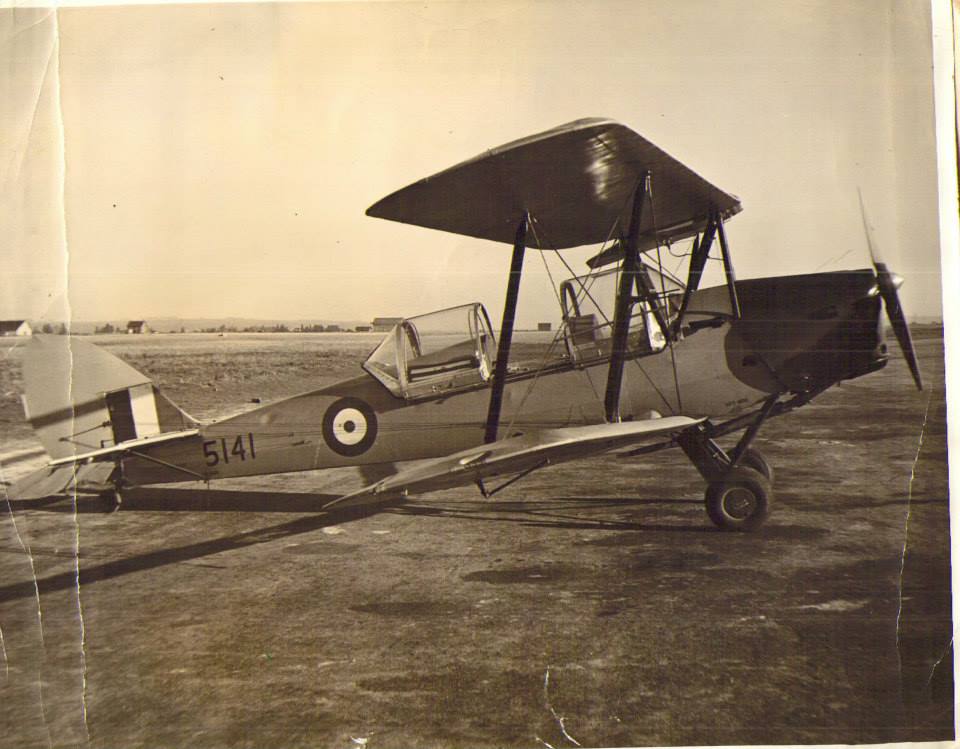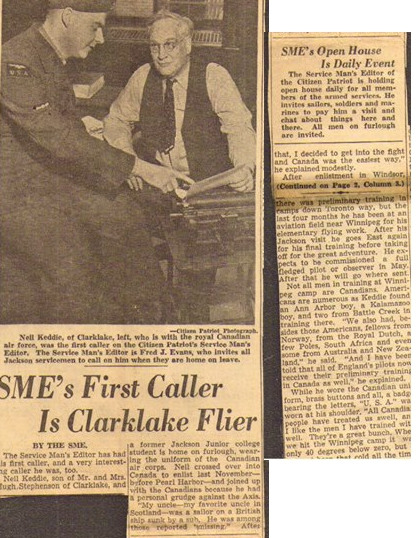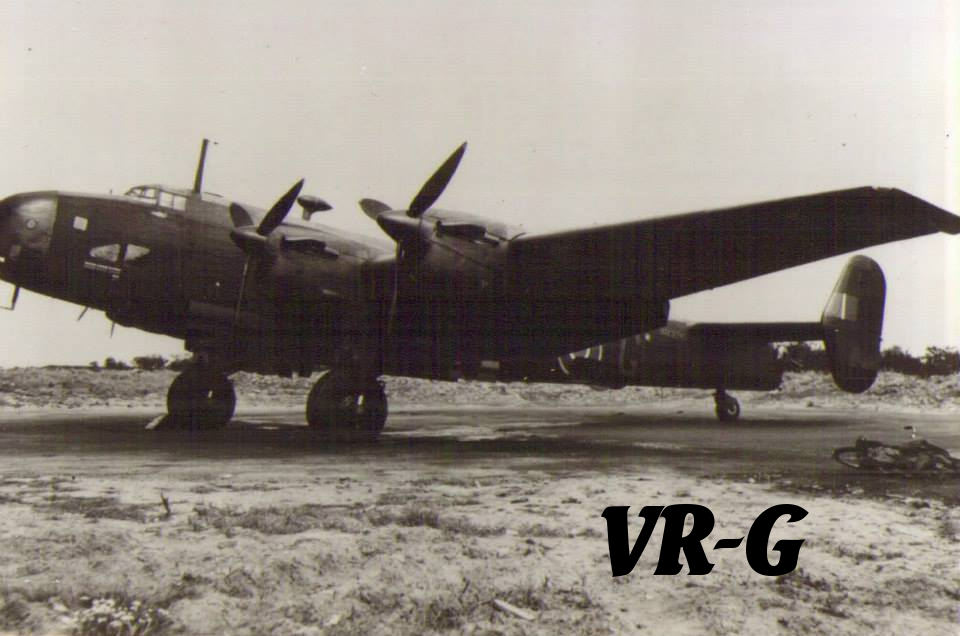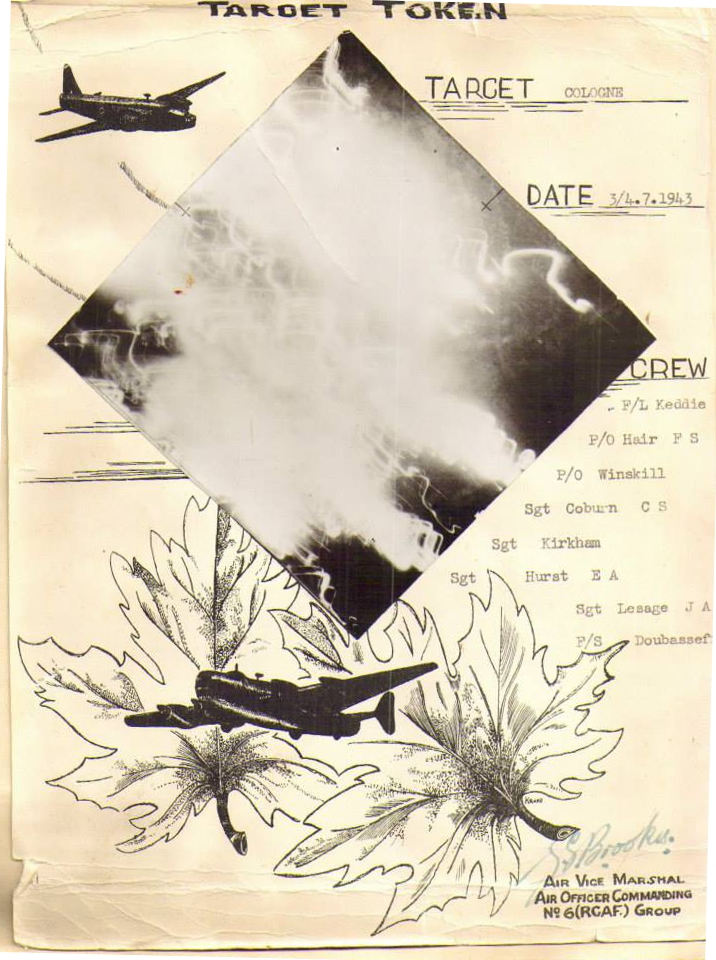From Michigan to the Skies Over Europe
September of 1941 found the United States in a difficult political situation, she was not at war with the Axis powers
but saw the need to keep Great Britain supplied with the necessary tools to hold back the Nazi war machine sweeping
across all of Europe.
Unable to officially supply Britain with aircraft, the U.S. simply flew the needed aircraft as close to the Canada-US
border as possible. Then the Canadians simply towed them across the border.

Not only were aircraft crossing the border to aid the RCAF, American citizens in large numbers came to the major
Canadian border cities and headed for the RCAF recruitment offices. Windsor Ontario recruiting office,
just across the river from Detroit was to see a number of Americans who would become Moosemen.
The thrill of flying was the driving force for all the recruits. Volunteering for aircrew and as a pilot was
the main objective for William Keddie another, perhaps a more personal cause was also in his mind. He left his hometown of Clarklake Michigan
headed for Windsor with the memory of his uncle, who had been lost when his ship was sunk by enemy action, in mind. Keddie born in Edinburgh
Scotland had the determination to take the fight back to a enemy whose main goal in 1941 was to invade the island
of Britain. That and an improved chance of becoming a pilot with the Canadian air force drew him to Canada.
Training Postings
After his Manning Depot training he was posted to No.5 I.T.S. at Belleville Ontario. Here he would be subjected to
the physical and psychiatric testing that would help the selection board screen the new recruits. The medical testing
included a four hour physical, which included time in a decompression chamber and test flights in an earth bound Link trainer.
The weeks here also included instructions on theory of flight, navigation, meteorology. Aspects of military life were
also included, duties of an officer, air force administration courses were mingled in with different mathematic courses.
After four weeks of ITS, it would be determined if Keddie would be selected as a pilot or instead be selected to one
of the other aircrew trades.
On January 2 of 1942 he along with all the others on that course waited as the instructor read off the results
finally he heard ...LAC Keddie - pilot
No. 14 EFTS
His next stop would be Portage la Prarie, Manitoba and No.14 E.F.T.S. Here pilot training was carried out on Tiger
Moths and Fleet Finches. The little De Haviland Tiger Moth, with it's 29 foot wing span, weighting in at just 1115 pounds empty presented a graceful and rather delicate
looking aircraft. Bright yellow with a 145 hp motor. This would be the introduction to airforce flying. A few days familiarization
and ground school then finally the day he suited up and with his parachute in place walked off to his first lesson.
Many of the instructors were civilians attached to the airforce, and had a way of testing the new flyers. Barrel rolls and loop the loops
and all kinds of maneuvers soon showed them the true metal of the trainee.

Flying both day and night exercises and being constantly scrutinized of his abilities to fly, being at a EFTS did
not automatically mean the airmen would become pilots. At this stage many would not make it and were transferred
to Navigation schools, Bomb and Gunnery schools.
No. 11 SFTS
By March 13th, LAC Keddie would find he made the cut and was posted to No.11 S.F.T.S at Yorkton Saskatchewan.
Yorkton was training grounds for multiple engine aircraft such as the Cessna Crane and the Avro Anson.
The Crane was a twin engine aircraft powered by two Jacobs L$MB engines, a heavier and much more powerful
aircraft then
the little Tiger Moth. A instrument panel now presented more dials and gauges, some duplicated for the twin engines
others needed where the Tiger Moth simply had no use for them.
Little time was wasted here, for most the day after arrival had them behind the dual controls, this time flying with RCAF or RAF
instructors. The whole pace was changed from the Elementary school days.

More intense and sometimes more dangerous exercises
were conducted, formation flying and bombing runs, where it was not only LAC Keddie's skills but also those flying around him
that would determine if they would be returning to base without incident.
Along with day and night training, cross country exercises and other skills in flying, the SFTS had training for
Armaments and pyrotechnics. Most repeated from his time at EFTS and now gone over again. Everything about SFTS showed a higher professional
approach to the training then the EFTS.
At Home On Leave

One benefit of the Service Flying schools were the Leaves granted to the trainee pilots. The pace of the course and
stress needed an outlet. At some point before he had completed his pilot training LAC Keddie made a visit home as seen in these
newspaper clippings from the Citizen Patriot.
When he returned to SFTS he completed his training and received his wings at a Wings Parade in mid-July 1942 .
419 Squadron
On February 26 1943, the newly commissioned, P/O Keddie arrived at 419 Squadron, on completion of his and his crew's training at No. 22 O.T.U and then
No.1665 CU. But for the captain of the aircraft, pilot P/O there was on more step before heading off
with his own crew on squadron operations. Two stints as 2nd. Pilot was mandatory for all pilots, his irst was on February 27th,
a "Gardening " op. followed the next night to St.Nazaire. Now he was ready to take his own crew on operations.
P/O Keddie's original crew were:
Navigator P/O E. S. Hair
B/A P/O A.S. Winskill
WAG Sgt. T.L. Walker
F/E Sgt. E.R. Kirkham
MU/G Sgt. F. D. Howells
R/G Sgt. Joseph Alexander Lesage
P/O Hair, P/O Winskill, and Sgt. Kirkham would remain with Keddie for the rest of their tour. Sgt. Joseph Lesage
would complete 24 operations with the crew.
Sgt.G.A.Hurst would join the crew on the April 16/17th operation, replacing Sgt Howells as gunner and would stay
on until the final operation.
P/O Coburn would replace Sgt. Walker and be with the crew for 26 operations, being replaced by Sgt. Bright.
Sgt. Lesage, was later killed on November 22 1943 while taking the place of another gunner on Halifax LW231,
captained by Sgt. W.L. Hunter. It was his first operation after leaving F/O Keddie's crew.
During the last seven operations Keddie's rear gunners would rotate between the Squadron Gunnery Leader F/L Kenyon
and F/O Wagner the future Squadron Gunnery Leader.

Squadron Operations
For his first operation P/O Keddie's aircraft developed a leak in the hydraulic system. His best choice was to return to base
most likely an agonizing decision considering it was his first operation. But he knew safety of the crew came first. The next seven
operations took the crew into Germany and to Berlin, all without incident.
However the next operation his aircraft had the escape hatch blow off and the rear turret became non-operational. There is no mention of which
hatch blew off, it may have been the rear turrets hatch or one of the aircrafts other hatches. The next night the aircraft again let the crew down. This
time the starboard outer engine failed.
Icing was a problem on many of the operations carried out by the squadrons crews. In F/O Keddie's case the situation
prompted one of the crew to ask "are we going to bail out, Skipper?" A simple "No" rely was all the crew needed, they
had full confidence in his ability to get them home safely.

May 12 1943
P/O Keddie and his crew completed just one more operation after the engine failure sortie, without any reported incidents.
The very next operation on May 12th to Duisberg, rear gunner Sgt. Lesage saw tracers pass over the aircraft.
He immediately called for a corkscrew
maneuver to throw the enemy night fighter off his aim. More tracers were seen but no hits are recorded. Lesage was unable to
return fire on the attacker because of the diving turning action of the Halifax presented no targetting on the night fighter.
July 13 1943 - 01.21 hours
Another twelve operations over Germany would be completed by Keddie and his crew. The next operation, a night
raid on Aachen, Sgt. Lesage was replaced by F/O Wagner. Wagner had already one night fighter destroyed to his credit
and was to become the Squadron Gunnery Leader in September.
Now as F/O Keddie headed towards Aachen, at 0121 hours rear gunner F/O Wagner spots an enemy aircraft approaching from astern. The
enemy aircraft has a white light showing on it's nose as it approaches and closes within 600 yards. Wagner fires off
three long bursts which seem to set the attacking aircraft on fire and then seen to drop several thousand feet falling through cloud cover.
An explosion is seen through the cloud cover which must have been the attacker hitting the ground. This enemy aircraft was
claimed as destroyed. Both the Mid-Upper gunner Sgt. Hurst and F/E Sgt. Kirkland confirmed the claim.
The night fighter had been a twin engine Ju88.
July 13 1943 - 02.15 hours
At 02.15 hours and flying at 19,000 feet, and returning from the target area rear gunner Wagner sighted an aircraft
on his Halifax's starboard quarter below at 1,200 yards in the dark side of the night sky. The aircraft sighted was
flying on a parallel course and same speed as VR-E, F/O Keddie's Halifax. The dark blur against the dark sky was
all of what Wagner could make out. Just the blurred outline of a distant aircraft, it was assumed at first to be
British, possibly another bomber heading home.
It continued to follow the Halifax in this manner for about two minutes. Then as this distant aircraft quickly turned
and climbed making it's intentions clear, Wagner gave Keddie the order to make a diving turn to starboard.
Wagner opened up fire on the attacker at about 700 yards with two long 100 round bursts. The rear gunner had thought his rounds had been hits, although no results were
observed.
The enemy aircraft did not return fire as it kept up the pursuit, finally breaking off his attack at 700 yards,
which is when F/O Wagner had opened fire with the four barrels of his gun throwing tracer at the approaching aircraft.
At this point the night fighter climbed to port, placing the moon behind it and enabling the Halifax gunners to
make out the silhouette of a FW 190. The last words of the Combat Report seem to imply that the fighter then took up
it's original position on the starboard side of F/O Keddie's Halifax. But mentions no more about it.
It was also stated in the Report that the Monica radar system failed to pick up the attacking aircraft before or during the
attack.
Completion of Tour - DFC
F/L Keddie completed six more operational flights including an attack on the rocket research base at Peenemunde and
a long range sortie to Milan Italy.
With his tour of 32 operations completed, F/L Keddie was screened and then
transferred to the USAAF. In October 1943 he was awarded the DFC.


Now a Captain in the USAAF, stationed at Maxwell Field in Alabama, wearing both his RCAF and USAAF wings and DFC ribbon.
Lt. Keddie's DFC presentation would be in June of 1944 and presented at a special ceremony in Washington
D.C. by the British Ambassador, Lord Halifax.
DFC Comments
As captain of aircraft, Flight Lieutenant Keddie has completed numerous bombing and mining sorties attacking
many of the enemy's most important targets in Germany. He has always displayed commendable courage and devotion
to duty while his cheerful confidence and splendid leadership have instilled confidence in his crew.








